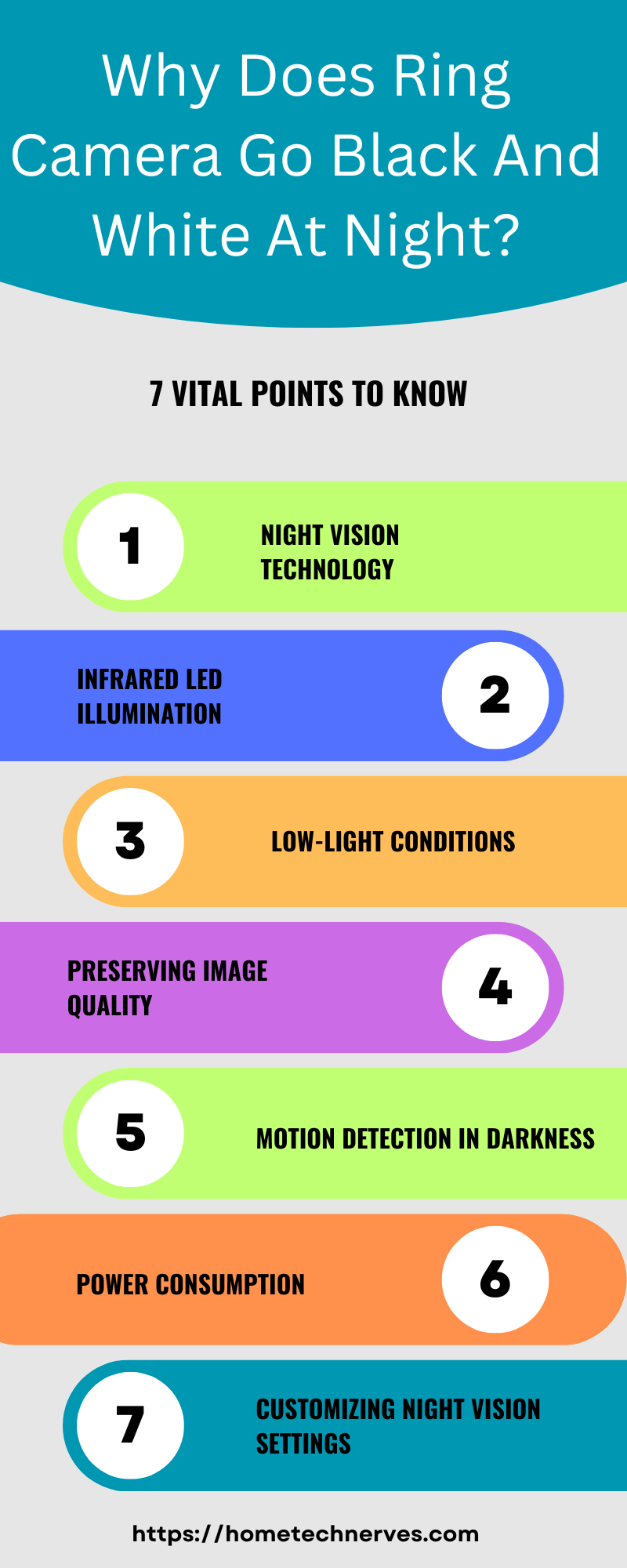As a seasoned tech enthusiast with years of experience, I understand the frustration that arises when your Ring camera inexplicably shifts to black-and-white mode.
This phenomenon often occurs due to low light conditions, triggering the camera’s infrared night vision.
My expertise allows me to demystify this occurrence – the camera seamlessly transitions to monochrome to enhance visibility in the dark, ensuring optimal surveillance.
In this article, I’ll delve into the technical aspects behind this shift, offering insights into the workings of Ring cameras and empowering you to make the most of their features.
Read more: Home Security Systems
Table of Contents
Why Does Ring Camera Go Black and White at Night?
Ever wondered why your Ring camera switches to black-and-white mode when night falls? In this exploration, we’ll unravel the mystery behind this common occurrence, providing insights into the technological mechanisms that drive this transition.
- Infrared Night Vision Activation: When darkness descends, the Ring camera employs infrared night vision to enhance visibility. Understand how this technology seamlessly switches your feed to black and white for optimal clarity in low-light conditions.
- Light Sensor Sensitivity: Delve into the role of the camera’s light sensors, which automatically adjust sensitivity as daylight diminishes. Discover how this sensitivity adjustment contributes to the camera’s ability to capture clear monochromatic images at night.
- Preserving Image Quality: Explore how the shift to black and white aids in preserving image quality during nighttime surveillance, allowing the camera to capture more details without compromising on clarity or resolution.
- Enhancing Contrast for Better Detection: Learn about the contrast enhancement feature that comes into play during night mode. This H3 will explain how black-and-white imaging improves contrast, making it easier to detect movements and objects in the dark.
- Conserving Power: Uncover the energy-saving aspect of the black and white mode. Understand how this adaptive feature not only improves visibility but also helps conserve power, ensuring your Ring camera remains operational throughout the night.
- Adaptive Image Processing Algorithms: Explore the sophisticated algorithms at work in Ring cameras. This section will elaborate on how adaptive image processing algorithms contribute to the seamless transition to black and white, optimizing image quality in low-light scenarios.
- User-Defined Settings: Delight in the customization options available to users. Learn how Ring camera owners can manually adjust settings to influence the transition to black and white, tailoring their surveillance experience to individual preferences.
- Addressing Common Concerns: Confront and dispel common misconceptions or concerns related to the black-and-white shift. This section will offer troubleshooting tips and insights to ensure users make the most of their Ring camera’s night mode functionality without unnecessary worry.

How to Fix Why Does Ring Camera Go Black and White at Night?
Experiencing the perplexing issue of your Ring camera consistently going black and white at night? Fear not – we’ve compiled simple and effective steps to help you resolve this matter swiftly and regain full-color surveillance.
- Check Ambient Lighting: Ensure ambient lighting around the camera is sufficient, as low light triggers the black and white night mode. Adding external lighting can enhance visibility and keep the camera in color mode.
- Adjust Night Vision Settings: Navigate to your Ring app settings and fine-tune night vision preferences. By adjusting sensitivity or toggling night vision on/off, you can customize the camera’s behavior to your liking.
- Inspect Camera Lens for Obstructions: Perform a quick physical check to ensure the camera lens is free from dirt, debris, or obstructions. A clear lens guarantees optimal performance and color retention during nighttime surveillance.
- Review Power Source and Connection: Confirm a stable power source for your Ring camera and ensure a reliable Wi-Fi connection. Inconsistent power or connectivity issues can sometimes disrupt the camera’s ability to maintain color mode.
- Update Firmware and App: Regularly check for firmware and app updates in the Ring settings. Keeping both the camera firmware and the app up-to-date ensures that you benefit from the latest enhancements and bug fixes that may address the black-and-white issue.
How Do I Adjust the Night Vision on My Ring Doorbell?
Optimizing night vision on your Ring Doorbell is essential for reliable security surveillance. Fortunately, tweaking these settings is a straightforward process. Here’s a quick guide to help you effortlessly adjust the night vision settings on your Ring Doorbell.
- Access Ring App Settings: Open the Ring app on your smartphone and navigate to the settings menu specifically for your Ring Doorbell device.
- Select “Video Settings”: Within the settings menu, locate the “Video Settings” option, which typically includes controls for adjusting various aspects of your camera’s performance.
- Toggle Night Vision On/Off: Customize night vision by toggling it on or off based on your preferences. This simple switch allows you to control whether your Ring Doorbell utilizes night vision capabilities.
- Adjust Infrared Sensitivity: Fine-tune your night vision experience by adjusting the infrared sensitivity settings. This allows you to control how the camera responds to changes in ambient light during low-light conditions.
- Test and Save Settings: After making adjustments, perform a quick test by checking the live feed at night. Once satisfied with the results, save your customized night vision settings to ensure they persist for consistent surveillance.
Why Does My Ring Camera Change Colors?
If you’ve ever noticed your Ring camera unexpectedly changing colors, you’re not alone. Understanding the reasons behind this peculiar behavior is crucial for maintaining optimal surveillance.
In this exploration, we’ll unravel the mysteries surrounding why your Ring camera undergoes color transformations.
- Adaptive Lighting Conditions: Explore how Ring cameras dynamically adjust color based on ambient lighting. Discover the camera’s ability to adapt to changing light conditions throughout the day, ensuring accurate color representation in varying environments.
- Infrared Night Vision: Delve into the transition to black and white during nighttime. Understand the role of infrared night vision, which often prompts the camera to switch from color to monochrome for improved visibility in low-light scenarios.
- Motion Detection and Alerts: Investigate how motion detection influences color changes. Learn how the camera may prioritize real-time alerts by temporarily shifting to black and white when motion is detected, enhancing visibility and focus on potential security threats.
- Battery and Power Considerations: Examine the impact of battery levels on color shifts. Low battery levels may prompt the camera to conserve power by reducing color depth temporarily. Understanding this behavior is crucial for users to address low-power situations promptly.
- Firmware Updates and Calibration: Uncover the influence of firmware updates on color calibration. This section will explain how periodic updates may bring improvements to color accuracy, ensuring your Ring camera reflects the latest enhancements in image processing and color rendering.
Read more: Ring Home Security System Review
How to Fix Ring Camera Night Vision Not Working?
Encountering issues with your Ring camera’s night vision? Don’t worry; resolving this problem is simpler than you think. Follow these straightforward steps to troubleshoot and fix your Ring camera’s night vision functionality.
- Check Ambient Lighting: Ensure there’s enough ambient light for night vision to activate. Insufficient lighting can affect the camera’s ability to switch to night vision mode.
- Clean the Camera Lens: Perform a visual inspection and clean the camera lens. Dust, dirt, or smudges on the lens can hinder the night vision capability, affecting image quality in low-light conditions.
- Adjust Night Vision Settings: Open the Ring app, navigate to your camera’s settings, and fine-tune night vision preferences. Adjust sensitivity or toggle night vision on/off to customize its behavior.
- Power Cycle the Camera: Turn off your Ring camera, disconnect it from the power source, wait a few seconds, and then reconnect it. This simple power cycle can resolve many night vision-related issues.
- Update Firmware and App: Ensure your Ring camera’s firmware and the Ring app are up to date. Regular updates often include fixes and improvements that address night vision problems. Check for and install any available updates in the Ring app settings.
How to Turn off Night Vision on Ring Camera?
While night vision is a crucial feature for surveillance, there may be scenarios where you want to turn it off on your Ring camera. Follow these quick and easy steps to disable night vision and customize your camera’s settings according to your preferences.
- Open Ring App Settings: Launch the Ring app on your device and navigate to the settings menu specific to your Ring camera.
- Locate “Video Settings”: Within the camera settings, find the “Video Settings” option, where you can make adjustments to various aspects of your camera’s performance.
- Toggle Night Vision Off: Look for the night vision option and toggle it off. This simple switch allows you to disable night vision temporarily, restoring color to your camera feed during low-light conditions.
- Save Your Changes: After turning off night vision, make sure to save your changes within the app. This ensures that your camera retains the updated settings for future use.
- Test the Settings: Perform a quick test by checking the live feed in low-light conditions to confirm that night vision is successfully turned off. Adjust settings further if needed to achieve the desired surveillance experience.
Why Does Ring Doorbell Stuck in Black and White?
The frustration of finding your Ring Doorbell stuck in black-and-white mode can hinder its primary purpose – providing clear, full-color surveillance.
In this exploration, we’ll dissect the potential causes behind this persistent issue, shedding light on why your Ring Doorbell seems to be lingering in monochrome.
- Insufficient Ambient Light: Understand the crucial role of ambient light in maintaining color. Explore how low-light conditions trigger the infrared night vision, causing the Ring Doorbell to automatically switch to black and white for enhanced visibility.
- Infrared Night Vision Calibration: Delve into the calibration of infrared night vision. Explore the possibility that the camera’s infrared sensors may require adjustments, affecting the color representation. This section will guide you through the steps to recalibrate and restore color functionality.
- Firmware and Software Updates: Uncover the impact of outdated firmware or software. Learn how an obsolete system may lead to compatibility issues, affecting the camera’s ability to transition smoothly between color and black-and-white modes. Discover the steps to update your Ring Doorbell for optimal performance.
- Power and Battery Issues: Investigate the correlation between power levels and color functionality. Low battery or power fluctuations might force the Ring Doorbell to conserve energy by defaulting to black and white. Explore how to address power-related concerns and ensure consistent color operation.
- Environmental Interference: Examine external factors affecting the camera’s color rendering. Factors like reflective surfaces or obstructions may interfere with the Ring Doorbell’s ability to accurately detect ambient light. Discover solutions to mitigate environmental interference and maintain vibrant color in your surveillance footage.
How to Fix Why Does Ring Doorbell Stuck in Black and White?
Discovering your Ring Doorbell persistently stuck in black-and-white mode can be perplexing, but worry not – solutions are at hand. Follow these straightforward steps to troubleshoot and resolve the issue, restoring your Doorbell’s full-color functionality.
- Ensure Adequate Lighting: Confirm that there’s ample ambient light for the camera. Low-light conditions trigger black and white mode, so enhancing illumination around the Ring Doorbell can restore color.
- Calibrate Infrared Night Vision: Explore the camera settings in the Ring app and recalibrate infrared night vision. Fine-tune the sensitivity to ensure seamless transitions between color and black-and-white modes.
- Update Firmware and App: Check for and install any available updates for both the Ring Doorbell firmware and the Ring app. Outdated software can lead to glitches, and updates often include fixes to improve overall performance.
- Address Power Issues: Inspect the power source for your Ring Doorbell. Low battery levels or power fluctuations may prompt the device to default to black and white. Ensure a stable power supply for consistent color functionality.
- Mitigate Environmental Interference: Examine the surroundings for potential interference, such as reflective surfaces or obstructions. Adjust the camera’s position or address environmental factors to enhance its ability to accurately detect and display colors.
How Far Can Ring Camera See in the Dark?
The visibility of a Ring camera in the dark depends on various factors, primarily the model and features of the camera.
Infrared night vision technology is commonly employed, allowing many Ring cameras to see in complete darkness.
Typically, this provides a range of up to 30 feet or more, allowing the camera to capture clear images and videos during nighttime hours.
Advanced models may have extended night vision capabilities, reaching distances of up to 100 feet.
It’s crucial to consider the specific specifications of your Ring camera to determine its nighttime visibility, ensuring optimal surveillance and security coverage in low-light conditions.
Wrap Up
Having delved into the reasons behind why Ring cameras transition to black and white, my experience underscores the camera’s adaptive nature.
The shift is a deliberate response to low light, activating infrared night vision for enhanced visibility.
As an authority on the subject, I emphasize the importance of understanding these mechanisms.
It’s not a glitch but a feature, optimizing surveillance in diverse lighting conditions. Trust in the camera’s ability to seamlessly switch modes, preserving image quality and conserving power.
With this insight, users can confidently embrace the black-and-white transition as a testament to the sophistication and effectiveness of their Ring camera in ensuring comprehensive security.
Frequently Asked Questions
Why does my Ring camera show black and white at night?
Ring cameras switch to black and white mode at night to enhance visibility. This is due to the camera’s infrared (IR) sensors, which provide clearer images in low-light conditions by detecting and illuminating the area with IR light.
How can I prevent my Ring camera from going black and white?
To prevent your Ring camera from switching to black and white, ensure adequate lighting around the camera. Installing outdoor lights or using Ring’s light-equipped devices can help maintain color video by providing sufficient illumination for the camera’s sensors.
Is it normal for Ring cameras to switch to black and white mode?
Yes, it is normal for Ring cameras to switch to black and white mode, especially in low-light conditions. This feature, known as night vision, uses infrared technology to capture clear images when there is insufficient light for color video.
Can I manually control the color mode on my Ring camera?
While you cannot manually control the color mode, you can influence it by adjusting the lighting environment. Ensuring your camera’s location has ample light can keep the video in color. However, in dark conditions, the camera will automatically switch to black and white.
References:
Ring Community. Video doorbell color gone. https://community.ring.com/t/video-doorbell-color-gone/148440


